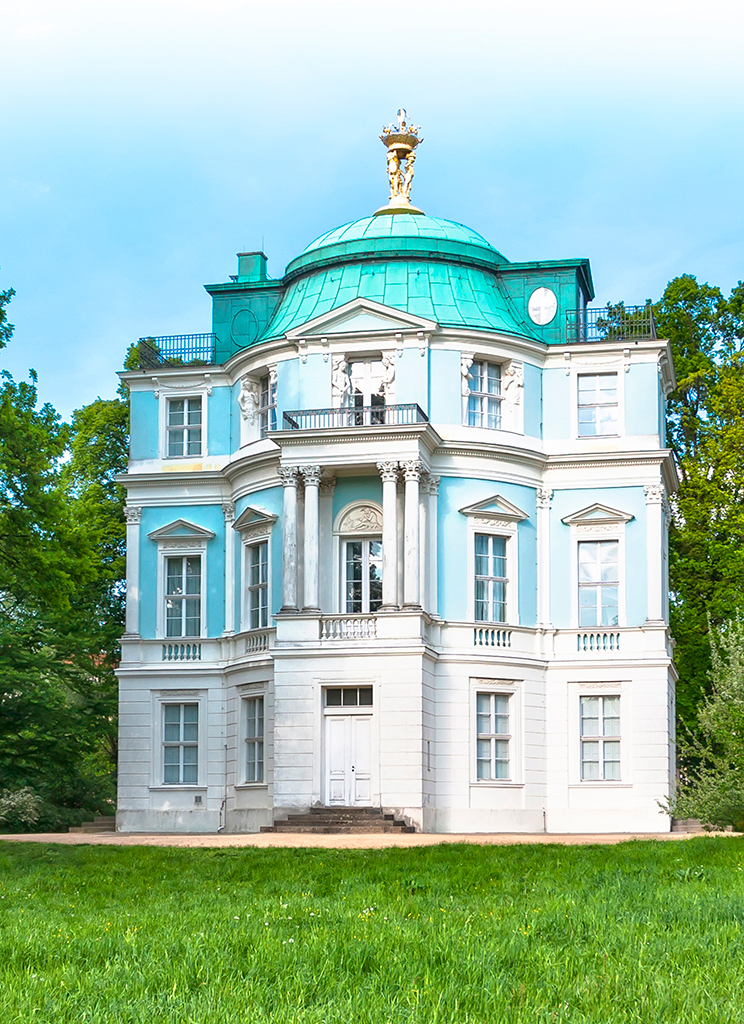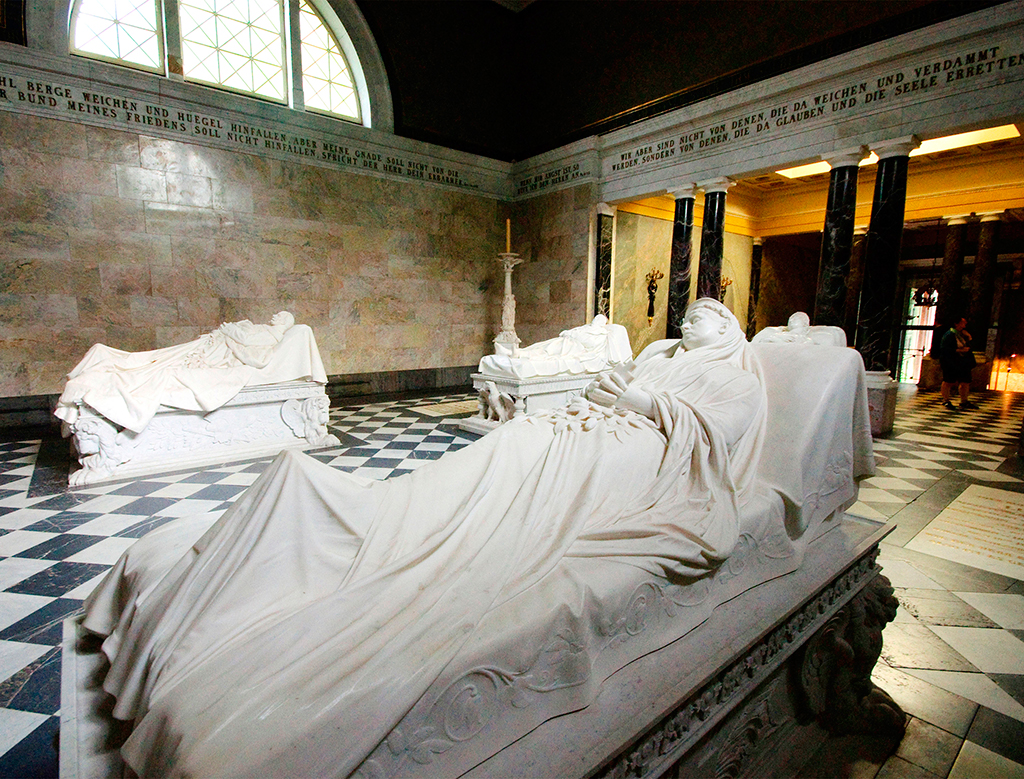The construction of Schloss Charlottenburg, designed as a summer residence for Sophie Charlotte, wife of the Elector Friedrich III, began in 1695. The Orangerie was extended and a cupola was added by Johann Friedrich Eosander between 1701 and 1713. The palace is being renovated in stages and is expected to be ready in 2017.
NEED TO KNOW
 Spandauer Damm • 030 32 09 10 • www.spsg.de
Spandauer Damm • 030 32 09 10 • www.spsg.de  Altes Schloss • Apr–Oct: 10am–6pm Tue–Sun (to 5pm Nov–Mar)
Altes Schloss • Apr–Oct: 10am–6pm Tue–Sun (to 5pm Nov–Mar) Neuer Flügel • Apr–Oct: 10am–6pm Wed–Mon (to 5pm Nov–Mar)
Neuer Flügel • Apr–Oct: 10am–6pm Wed–Mon (to 5pm Nov–Mar) Belvedere • Apr–Oct: 10am–6pm Tue–Sun (the Belvedere is closed in the winter Nov–Mar)
Belvedere • Apr–Oct: 10am–6pm Tue–Sun (the Belvedere is closed in the winter Nov–Mar) Neuer Pavillon • Apr–Oct: 10am–6pm Tue–Sun (to 5pm Nov–Mar)
Neuer Pavillon • Apr–Oct: 10am–6pm Tue–Sun (to 5pm Nov–Mar) Mausoleum • Apr–Oct: 10am–6pm Tue–Sun (to 5pm Nov–Mar)
Mausoleum • Apr–Oct: 10am–6pm Tue–Sun (to 5pm Nov–Mar) Museum Berggruen • Schlossstr. 1 • www.smb.museum • 10am– 6pm Tue–Sun • Admission charge (for all)
Museum Berggruen • Schlossstr. 1 • www.smb.museum • 10am– 6pm Tue–Sun • Admission charge (for all)- The Orangery Café has an attractive garden.
- Try a romantic midweek evening stroll to avoid the crowds (park: 6am–dusk).

1.Altes Schloss
The Baroque tower of the oldest part of the palace (dating to 1695) by Johann Arnold Nering is crowned by Richard Scheibe’s golden statue of Fortuna.

Altes Schloss
2.Porzellankabinett
This small, exquisite mirrored gallery has been faithfully restored to its original glory. Among the exhibits on display are valuable porcelain items from China and Japan.

Porzellankabinett
3.Schlosskapelle
The luxurious splendour of the palace chapel recalls the once magnificent interior design of the palace, before it was destroyed in World War II. However, apart from the original altar, the entire chapel – including the king’s box – is a costly reconstruction.
4.Monument to the Great Elector
The equestrian statue of the Great Elector Friedrich Wilhelm is thought to be one of his most dignified portraits. Made by Schlüter in 1696–1703, it stood on the Rathausbrücke originally, near the destroyed Stadtschloss.

Monument to the Great Elector
5.Neuer Flügel
Built between 1740 and 1747 by Georg W von Knobelsdorff, the new wing contains Frederick the Great’s private quarters, as well as a large collection of 18th-century French paintings.
6.Schlosspark
The palace has a lovely Baroque garden, beyond which lies a vast park, redesigned by Peter Joseph Lenné in 1818–1828 in the English style with rivers, artificial lakes and small follies.
7.Belvedere
Friedrich Wilhelm II liked to escape to the romantic Belvedere, a summer residence built in 1788 by Carl Gotthard Langhans, which served as a tea pavilion. Today it houses a collection of precious Berlin porcelain objects.

Belvedere
8.Neuer Pavillon
This Italianate villa, designed by Schinkel for Friedrich Wilhelm III in 1825, was inspired by the Villa Reale del Chiatamone in Naples and clearly shows the Hohenzollerns’ love of the Italian style.
9.Mausoleum
Slightly hidden, this Neo-Classical building by Schinkel is the final resting place of many of the Hohenzollerns.

Mausoleum
10.Museum Berggruen
Situated in the Western Stüler Building opposite the Charlottenburg palace, this modern art gallery houses the permanent exhibition “Picasso and his Time”, featuring more than 100 works that span the artist’s career. Other highlights of the collection include works by Matisse, Klee and Giacometti (for further details see Museum Berggruen).

Schloss Charlottenburg Rooms
1.Goldene Galerie
The festival salon in the Neuer Flügel, 42 m (138 ft) long, was designed in Rococo style by Frederick the Great’s favourite architect von Knobelsdorff. The richly ornamented room has a cheerful appearance.

Goldene Galerie in the Neuer Flügel
2.Eichengalerie
The wooden panelling of the Oak Gallery is carved with expensively gilded portraits of Hohenzollern ancestors.
3.Gris-de-Lin-Kammer
This small chamber in Friedrich’s second palace apartment is decorated with paintings, including some by his favourite artist, Antoine Watteau. The room was named after its wall coverings in violet-coloured damask (gris-de-lin in French).
4.Schlafzimmer Königin Luise
Queen Luise’s bedchamber, designed in 1810 by Karl Friedrich Schinkel, features the clear lines typical of the Neo-Classical style. The walls are clad in silk fabrics and wallpaper.
5.Winterkammern
Friedrich Wilhelm II’s early Neo-Classical rooms contain fine paintings, tapestries and furniture.
6.Bibliothek
Frederick the Great’s small library has outstanding elegant bookcases and a vibrant, light green colour scheme.
7.Konzertkammer
Furniture and gilded panelling in the concert hall have been faithfully recreated as during Frederick the Great’s time. Antoine Watteau’s Gersaint’s Shop Sign, considered to be one of his most significant works, hangs here; the king bought the work directly from the artist.
8.Grünes Zimmer
The green room in Queen Elisabeth’s quarters is an excellent example of royal chambers furnished in 19th-century Biedermeier style.

Queen Elisabeth’s Grünes Zimmer
9.Rote Kammer
The elegant chamber, decorated entirely in red and gold, is adorned by portraits of King Friedrich I and Sophie Charlotte.
10.Friedrich I’s Audienzkammer
The ceiling paintings and Belgian tapestries depict allegorical figures symbolizing the fine arts and the sciences. There are also magnificent lacquered cabinets, modelled on Asian originals.
THE HOHENZOLLERNS AND BERLIN
In 1412, Burggraf Friedrich of the Hohenzollern dynasty of Nuremberg was asked by Sigismund of Luxemburg to support him in the princely feuding before the imperial election for the throne. When Sigismund became king, he gave Friedrich, in 1415, the titles of Margrave and Prince-Elector of Brandenburg as a reward for his services – this is where the histories of the Hohenzollerns and Berlin first became entwined, a relationship that was to last for 500 years. From the start, the family tried to limit the powers of the town and of the Brandenburg nobility. Culture, however, flourished under the new rulers, especially the Great Elector 200 years later, who invited 20,000 Huguenot craftsmen to Berlin and founded an art gallery and several schools. His grandson Friedrich Wilhelm I, father of Frederick the Great, transformed the city into a military camp, with garrisons and parade grounds, and scoured the town for tall men to join his bodyguard. In the 19th century, however, relations between Berlin and the Hohenzollerns became decidedly less cordial.

Friedrich Wilhelm, the Great Elector

The Great Elector Receiving Huguenot Refugees, 18th-century etching by Daniel Chodowiecki
TOP 10 HOHENZOLLERN RULERS
the Great Elector (1620–88)
(1657–1713)
(1688–1740)
the Great (1712–86)
(1744–97)
(1770–1840)
(1795–1861)
(1797–1888)
(1831–88)
(1859–1941)


